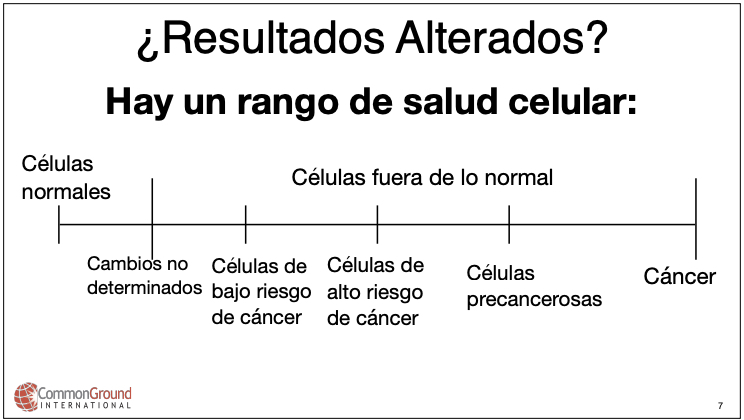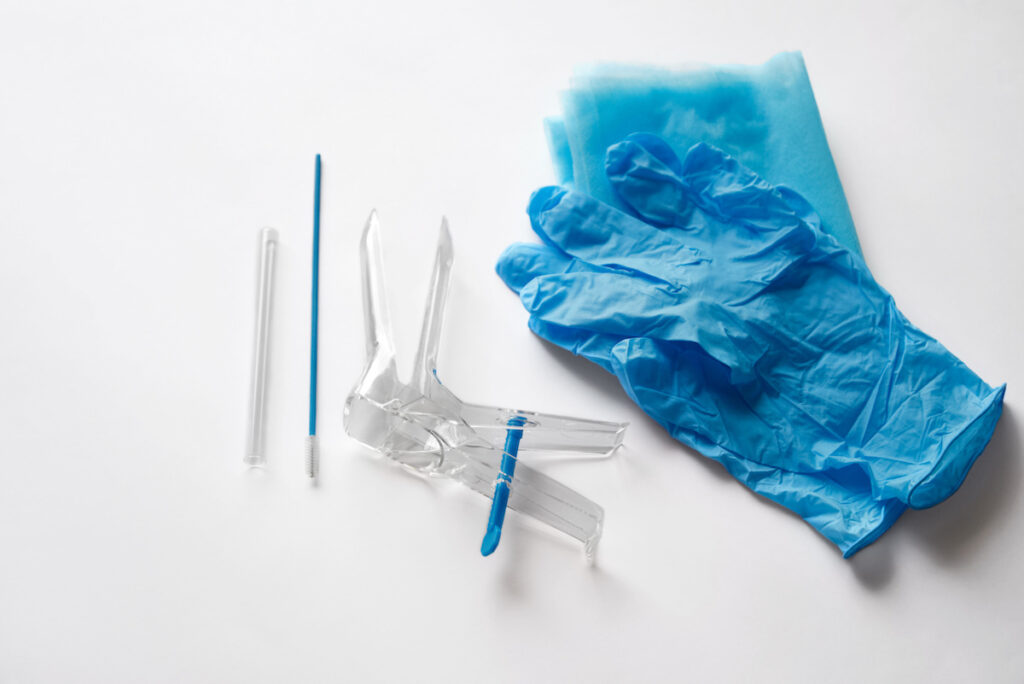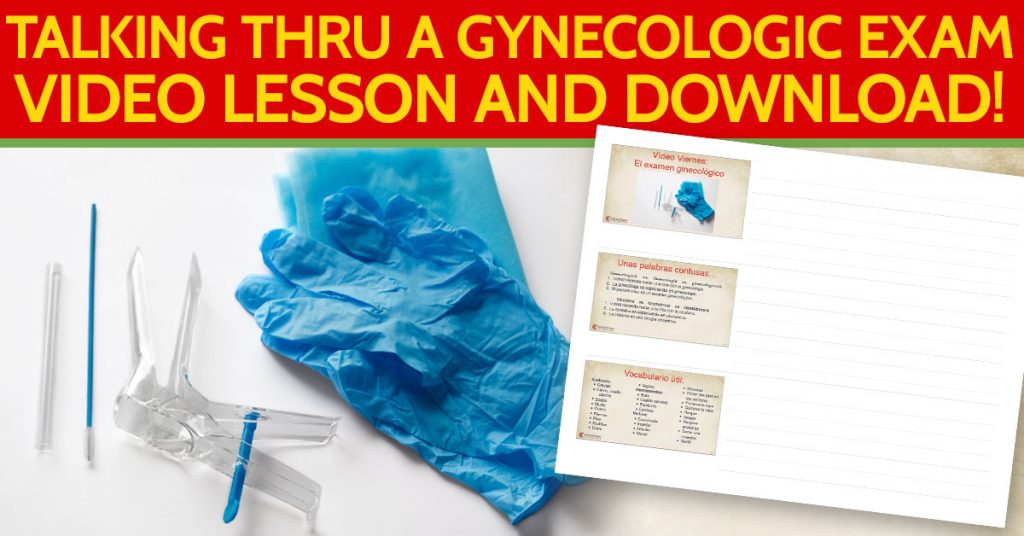Do you ever have to discuss Pap tests or colposcopies in Spanish? How about abnormal Pap test results? Here is a brief lesson to guide you:
Here is some essential pap test vocabulary from the lesson:
Pap Test Anatomy:
- Células anormales: Abnormal cells
- Cérvix, Cuello uterino: Cervix
- Células normales: Normal cells
- Muslo: Thigh
- Ovario: Ovary
- Piernas: Legs
- Pies: Feet
- Rodillas: Knees
- Útero: Uterus
- Vagina: Vagina
Realated problems/conditions:
- Cáncer: Cancer
- Infección: Infection
- Infección, Enfermedad de transmisión sexual: Sexually transmitted infection, disease
- Inflamación: Inflammation
- Quiste: Cyst
- Sangrado entre periodos: Bleeding between periods
- Sangrado irregular: Irregular bleeding
- VPH – Virus Papiloma Humano: HPV
Pap test tools and supplies:
- Bata: Gown
- Cepillo cervical: Cervical brush
- Colposcopio: Colposcope
- Cureta: Curette
- Espátula: Spatual
- Espéculo: Speculum
- Mesa de exámenes: Exam table
- Reposapiés (estribos): Footrests (stirrups)
Other pap test vocabulary
- Cómodo / Incómodo: Comfortable / uncomfortable
- Flujo abundante: Heavy flow
- Flujo leve: Light flow
- Manchas entre periodos: Spotting between periods
- Muestra de células: Cell sample
- Sentir dolor: Feel pain
- Regular / Irregular: Regular / Irregular
Useful verbs for the pap test
- Dejar las rodillas caer: Let your knees fall
- Examinarle: Examine you
- Insertar: Insert
- Intentar: Try
- Mover: Move
- Moverse: Scoot
- Poner los pies en el reposapiés: Put your feet in the footrests
- Ponerse la ropa: Put on your clothes
- Quitarse la ropa (de las caderas hacia abajo): Take off your clothes (fro the hips down)
- Raspar células: Scrape cells
- Recoger células: Collect cells
- Relajar: Relax
- Respirar profundo: Breathe deeply
- Sacar una muestra: Take a sample
- Sangrar: Bleed
- Sentir dolor, presión: Feel pain, pressure
- Ver de cerca: See up close
Need a reminder on how to form the usted command tense and convert those verbs above into useful pap test instructions?

Usted Medical Spanish Formal Commands
Whether you’re giving hand washing instructions, talking about how to take medications, or simply directing someone to follow you, you’re going to use Spanish formal commands.
Usted is the subject that you use day in and day out with your adult patients. So, usted is the verb form you always want to use with formal Spanish commands as well.
Click here to learn Formal Medical Spanish Commands for your pap test conversations
Explaining the Pap smear in Spanish:
- The Pap test is a screening test for abnormal cells in your cervix. El examen de Papanicolaou es un examen de detección de células anormales en el cuello uterino (cervix)
- These abnormal cells can become cancerous cells. Estas células anormales pueden convertirse en células cancerosas.
- We do Pap tests to prevent cervical cancer. Realizamos el examen de Papanicolaou para prevenir el cáncer del cuello uterino (cervix).
What is a Pap Smear like?
It’s a pelvic exam. Es un exámen pélvico.
- You’ll take off your clothes (from the hips down) and put on this gown. Usted va a quitarse la ropa (de las caderas hacia abajo) y ponerse esta bata.
- Then you’ll get on the exam table and put your feet in the footrests and allow your knees to fall to the sides. Luego se sube a la mesa de exámenes y pone sus pies en los reposapiés mientras deja caer las rodillas hacia los lados.
- I”ll examine your vagina and then insert the speculum into your vagina to open its walls. Yo voy a examinarle la vagina y luego introducir el espéculo en la vagina para abrir las paredes de la vagina.
- Then I’ll insert the cervical brush to take a cell sample. Luego voy a insertar el cepillo cervical para recoger una muestra de células.
- It’s an uncomfortable exam. You will feel pressure and a little pain. Es un examen incómodo. Usted va a sentir presión y un poquito de dolor.
- We analyze the cell sample in the lab and we’ll let you know if there is any abnormal result within # days / weeks. Analizamos la muestra de células en el laboratorio y le avisamos si hay algún resultado anormal dentro de # días / semanas.
- How to describe abnormal results and suggest next steps:
Explaining the range of cellular health:
- There is a range of cell health. Hay un rango de salud celular.
- There are normal cells. Hay células normales.
- And there are abnormal cells. Y hay células fuera de lo normal.
- Cell changes that we can’t determine. Cambios celulares no determinados
- Cells with low cancer risk. Células de bajo riesgo de cáncer.
- Cells with high cancer risk. Células de alto riesgo de cáncer.
- Precancerous cells. Células precancerosas.
- Cancer. Cáncer

More detail about abnormal cervical cells & next steps:
- ASC-US: There are some changes in the cervical cells. Hay cambios en las células del cuello uterino. They indicate the presence of HPV. Indican la presencia de VPH. The could be precancerous cells. Pueden ser células precancerosas. We need to do a HPV test. Necesitamos hacer una prueba de VPH.
- SIL: There are some areas of abnormal tissue (lesions) that can become cancerous. Hay áreas de tejidos anormales (lesiones) que pueden llegar a ser cancerosos. Some of these lesions may resolve on their own but others need to be removed to prevent cancer. Algunas de estas lesiones se resuelven pero otros necesitan quitarse para prevenir cáncer. We need to do a HPV test and a colposcopy. Necesitamos hacer una prueba de VPH y una colposcopia.
- ASC-H: There are abnormal cells on your cervix. Hay células anormales en el cuello uterino. They can become cancerous. Pueden llegar a ser cancerosas. We need to do a HPV test and a colposcopy. Necesitamos hacer una prueba de VPH y una colposcopia.
- AGC: These glandular cells on your cervix can indicate precancer in the uterus and in the cervix. Estas células glandulares en el cuello uterino pueden indicar precáncer en el útero o en el cuello uterino. We need to do an endocervical curettage to take more tissue samples from the cervix and also take some samples of the endometrium. Necesitamos hacer un raspado endocervical para sacar más muestras de tejido del cuello uterino y también tomar muestras del endometrio.
- Cáncer: There are cancerous cells on your cervix. Hay células cancerosas en el cuello uterino. At this time, we need to determine the best treatment: LEEP, surgery, radiation therapy, chemotherapy, etc. En este momento necesitamos determinar el mejor tratamiento: LEEP, cirugía, radioterapia, quimioterapia, etc.
How to describe a colposcopy in Spanish:
- A colposcopy is a screening test for cervical cancer. La colposcopia es una prueba para detectar cáncer del cuello uterino.
- It’s like a pair of binoculars with a bright light. Es como un par de binoculares con una luz brillante.
- It allows us to see the cervix up close. Nos permite ver muy de cerca su cuello uterino.
- We use a speculum to open the vagina like we do in a pap test, but the colposcope doesn’t touch nor enter the vagina. Usamos un espéculo para abrir la vagina igual como usamos en el examen de Papanicolaou, pero el colposcopio no toca ni entra su vagina.
- If it’s necessary to take a tissue sample for biopsy, you will feel pressure and a little pain while we collect the sample. Si es necesario sacar una muestra de tejido para una biopsia, usted sentirá presión y un poquito de dolor mientras recogemos la muestra.
Now use the vocabulary and phrasing above to practice some pap test conversations with your conversation partner*.
- Take a few minutes to explain what a Pap test is and why it’s important. Answer your patient’s questions about the test.
- Talk through the steps of the Pap test as if you’re performing it. Try to politely integrate the command tense (using usted) into your instructions.
- Your patient needs a colposcopy. Explain to her why, what to expect, how to prepare for it, and then talk through the procedure.
- Share abnormal results with your patient. Explain the possibilities and next steps for her.
*If you don’t have a conversation partner, head over to the Learning Medical Spanish Facebook Group to put yourself out there and find one!
Other posts in this women’s health series:
Discussing Birth Control & Contraception Options in Spanish
When you talk about contraception in Spanish, you generally cover a handful of subtopics: cost,…
How to explain periods, menstrual cramps and bleeding in Spanish
Do you ever have to discuss periods, menstrual cramps and menstrual bleeding in Spanish? If…
Brief Prenatal Education Review in Spanish
For this week’s topic: Prenatal Education Review in Spanish, I thought I’d share some activities,…
Well Woman Visits in Spanish
Here is the video lesson: https://youtu.be/yGZ84c8-dyw This is lesson 4/5 in our Spanish Well Visits…
How to Talk Through a Gynecologic Exam in Spanish
El examen ginecológico | The gynecological exam in Spanish This Medical Spanish lesson includes all the vocabulary…











On the OBGYN video are some terms that are not right, like reposapie, you wont find that word on RAE, flujo is not flow on that context is discharge….and few other. Maybe would a good idea to review them with your team.
Have a blessed day!!
Elena Ruiz Asheville NC
[email protected]
Hi Elena, thanks for the comments. Not sure if you work in OB/GYN? These terms, at least in the Denver area, are very commonly used by patients and providers alike. The RAE of course has a long history of not keeping up with everyday terms and common people’s use of the language.